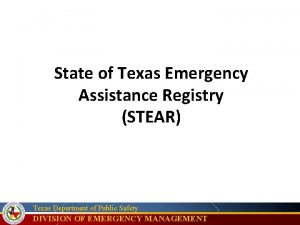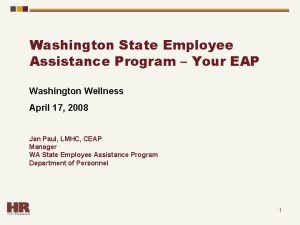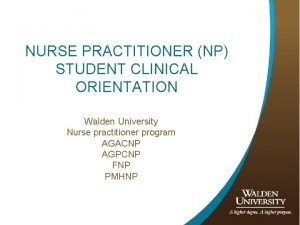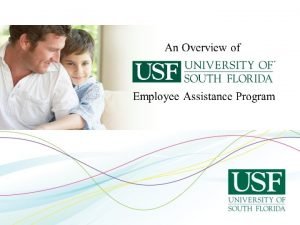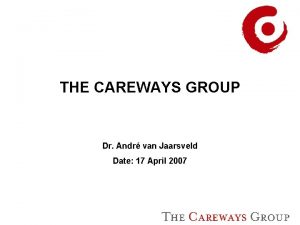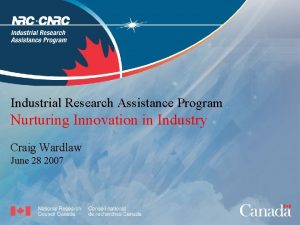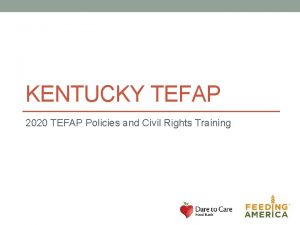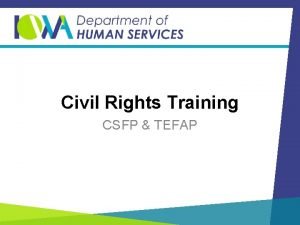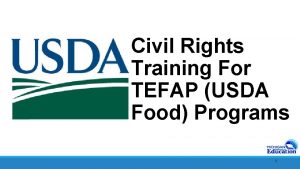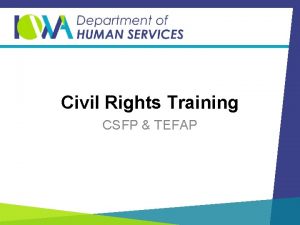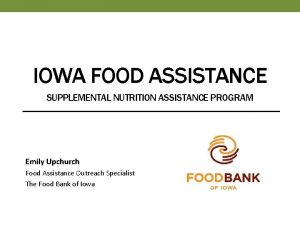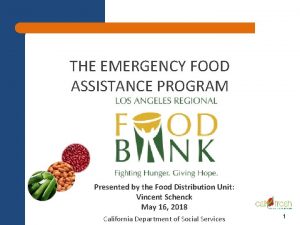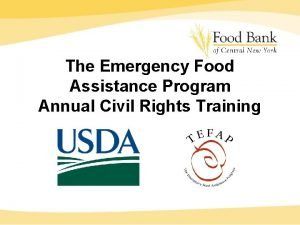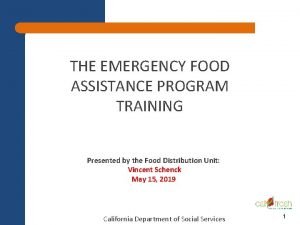THE EMERGENCY FOOD ASSISTANCE PROGRAM TEFAP Rachel Jennings












- Slides: 12

THE EMERGENCY FOOD ASSISTANCE PROGRAM (TEFAP) Rachel Jennings Community Nutrition 6/10/2015

WHO DOES THE PROGRAM SERVE? § Those of low-income status and the homeless § Households that meet State criteria § Many programs benefit from TEFAP

HOW MANY PEOPLE ARE SERVED? Illinois Indiana Michigan Minnesota Ohio Wisconsin TOTAL-MWRO TOTAL FOOD ENTITLEMENT TOTAL ADMINISTRATIVE FUNDS FOOD AND ADMINISTRATIVE ENTITLEMENT $10, 324, 779 $5, 481, 157 $8, 009, 188 $2, 967, 034 $9, 289, 373 $3, 764, 370 $39, 835, 901 $2, 865, 402 $1, 024, 535 $2, 568, 837 $951, 635 $1, 736, 364 $1, 207, 370 $10, 354, 143 $13, 190, 181 $6, 505, 692 $10, 578, 025 $3, 918, 669 $11, 025, 737 $4, 971, 740 $50, 190, 044

WHO PROVIDES THESE SERVICES? § United States Department of Agriculture – USDA §Each State receives food from the USDA according to their need §Eligibility for households vary by State § The food is packaged and shipped to the State where it is then distributed to food pantries, banks and soup kitchens § The food is distributed for home use or prepared meals as determined by the organization

ROLE OF RD + ACADEMY POSITION §Teach people how to use the foods to make better meals § Help families with meal planning § Encourage people to use the system if needed – no family should ever starve It is the position of the American Dietetic Association that systematic and sustained action is needed to achieve food and nutrition security for all in the United States. To eliminate food insecurity, interventions are needed, including adequate funding for and increased utilization of food and nutrition assistance programs, inclusion of food and nutrition education in such programs, and innovative programs to promote and support individual and household economic self-sufficiency. More than 49 million individuals living in the United States experienced food insecurity in 2008. Negative nutrition and non–nutrition-related outcomes have been associated with food insecurity in children, adolescents, and adults, including substandard academic achievement, inadequate intake of key nutrients, poor health, increased risk for and development of chronic disease, poor disease management, and poor psychological and cognitive functioning. Registered dietitians and dietetic technicians, registered, can play key roles in ending food insecurity and are uniquely positioned to make valuable contributions through provision of comprehensive food and nutrition education; competent and collaborative practice; innovative research related to accessing a safe, secure, and sustainable food supply; and advocacy efforts at the local, state, regional, and national levels.

WHAT THE PROGRAM DOES + COMMUNITY NEEDS FOR DEMAND OF PROGRAM According to the USDA, “The amount of food each State receives out of the total amount of food provided is based on the number of unemployed persons and the number of people with incomes below the poverty level in the State” § There will always be people in need of food § Food is NOT a basic human right therefore programs are in place to help those who can’t purchase food.

PROGRAM GOALS § To feed food insecure individuals and help them be as healthy as possible, foods include: §Dried beans §Pasta products §Milk §Rice/grits/cereal §Soups §Canned and dried fruits §Canned vegetables §Fruit juice §Dried egg mix §Meats/poultry/fish § To help the elderly and those in poverty

HEALTHY PEOPLE 2020 NWS-12 Eliminate very low food security among children 1. 3 percent of households with children had very low food security among children in 2008 NWS-13 Reduce household food insecurity and in doing so reduce hunger • 14. 6 percent of households were food insecure in 2008

WHEN + WHERE ARE SERVICES PROVIDED? §The services are provided country wide annually, however the eligibility requirements vary by state § To find out more information about Michigan’s program go to http: //www. michigan. gov/mde/0, 4615, 7 -140 -43092_61446 ---, 00. html

DOES THE PROGRAM MEET COMMUNITY NEEDS? § Yes https: //www. youtube. com/watch? v=KFz. G 6 s. Jj. Hbw

REFERENCES Food Insecurity in the United States. American Dietetic Association. 2010; 110: 1368 - 1377. Michigan Department of Education: Food Assistance Programs. 2013. Available at: http: //www. michigan. gov/mde/0, 4615, 7 -140 -43092_61446 ---, 00. html The Emergency Food Assistance Program. 2013. Available at: https: //www. youtube. com/watch? v=KFz. G 6 s. Jj. Hbw United States Department of Agriculture: The Emergency Food Assistance Program. 2014. Available at: http: //www. fns. usda. gov/sites/default/files/pfs-tefap. pdf

QUIZ 1. What does TEFAP stand for? a. The Educational Functional and Additional Product b. The Emergency Food Assistance Program c. Technical Emergency Assistance Program 2. How much money does Michigan receive for food assistance? 3. True or False, Food assistance programs are only for the elderly 4. Food available to recipients include what? a. Dried beans b. Pasta products c. Milk d. all of the above 5. True or false, eligibility for the program is the same for each state
 State of texas emergency assistance registry
State of texas emergency assistance registry Weatherization assistance program virginia
Weatherization assistance program virginia Employee assistance program washington
Employee assistance program washington Nehemiah down payment assistance program
Nehemiah down payment assistance program Walden student assistance program
Walden student assistance program Employee assistance program townsville
Employee assistance program townsville Adsd training
Adsd training Virginia law enforcement assistance program
Virginia law enforcement assistance program Usf eap
Usf eap Careways employee wellness programme
Careways employee wellness programme Industrial research assistance program
Industrial research assistance program Weatherization assistance program missouri
Weatherization assistance program missouri Industrial research assistance program
Industrial research assistance program
